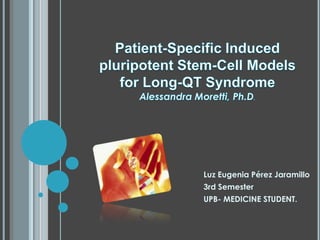
Patient specific induced pluripotent stem-cell models for long-qt syndrome
- 1. Patient-SpecificInducedpluripotentStem-CellModelsfor Long-QT SyndromeAlessandraMoretti, Ph.D. Luz Eugenia Pérez Jaramillo 3rd Semester UPB- MEDICINE STUDENT.
- 4. TIPE I MUTATION IN THE KCNQ1 GENE Encoding KvQTI protein (alpha subunity of the Iks Canals)
- 5. Stem cells Characterized by the ability to renew themselves through mitotic cell division and differentiate into a diverse range of specialized cell types. Embryonic stem cells Adult stem cells That are found in adult tissues From the inner cell mass of blastocysts
- 8. Induced Pluripotent Stem Cells Type of pluripotent stem cell artificially derived from a non- pluripotent cell, typically an adult somatic cell, by inducing a "forced" expression of specific genes.
- 9. (1)Isolated and growth the donant cells. (2)Make a transfection of gene stem cells from the donor cellsby means of viral. (3)Cells were growth with strategies for growing stem cells using mitotically inactive fibroblasts (4)A small subset of these transfected cells become induced pluripotent stem cells
- 10. STEM CELLS IMPORTANCE Offers the opportunity to produce large numbers of patients -pecific Stem cells. If someone has certain cells that don’t function properly or that have been damaged, then stem cells could be used to replace those damaged cells.
- 11. In this study for example; these showedthe capacity of these cells to give rise to functional cardiomyocytes that recapitulate the electrophysiological characteristics of the disorder.
- 12. objetive Observe inducedstem-cellmodels of patient-specificwithlong- QT Syndrome.
- 13. metodos
- 14. HISTORIA CLINICA Y FENOTIPO GENETICO HIPERACTIVO EN ELECTROCARDIOGRAMA CON DEFICIT DE ATENCION INTERVALO QT LARGO MUTACION EN EL GEN KCNQ1 (CAMBIO DE BASE (569G->A)
- 16. Después de 6 días Se sembraron en HASTA QUE APARECEN Células infectadas Murino embrionarias Colonia de células madre
- 17. (Células madre pluripotentes inducidas)
- 18. Diferenciación cardiaca in vitro 3 día- Indujeron las células madres pluripotenciales como cuerpos embrionarios separando las células madre 4 día- El medio fue reemplazado 20% suero fetal bovino
- 19. 7 día- Los cuerpos embrionarios fueron recubiertos por gelatina. 20-30 días- Las áreas que mostraron excitación espontanea (indicativo de diferenciación cardiaca), fueron micro disecadas y recubiertas por Fibronectina y suero fetal bovino (2%)
- 20. EVALUACIONES DE INMUNOHISTOQUIMICA Nanog (Abcam), TRA-1-81 (BD Pharmingen), cardiactroponin T (Lab Vision),α-actinin (Sigma–Aldrich), myosin light chain 2a and myosin light chain 2v (Synaptic Systems), KCNQ1 (Abcam),y proteinadisulfidoisomerasa (Abcam).
- 21. Ensayos de reacción en cadena de la polimerasa (pcr) Para amplificar la región mutada del gen KCNQ1para secuenciación. Para la evaluación de la expresión de los genes de pluripotencialidad, transgenes retrovirales, y marcadores de linaje celular.
- 22. PROPIEDADES DE LAS CÉLULAS MADRE
- 23. La trasncriptasa inversa (RT)- PCR se utilizo para marcar los fenotipos de miocardiocitos individuales.
- 25. - Presencia de genes pluripotenciales en cada una de las capas embrionarias. (clones de células madre embrionarias) (KTR14, NCAM1) (PDX1, SOX7, y AFP) (CD31, DESMIN, ACTA2, SCL, MYL2, y CDH5)
- 26. VALORACION DEL TIPO DE SINDROME DE QT LARGO Focos de contratación comenzaron a aparecer después de aprox. 12 días de diferenciación. Adaptación en pacientes con SQTL
- 27. PAPEL DE R190Q-KCNQ1 Con el uso de RT-PCR Se observo KCNQ1 Fueron similares en células control y las de los sujetos con SQTL
- 28. Ubicación del KCNQ1 en la celula CÉLULAS CONTROL CÉLULAS DE SUJETOS CON SQTL En la membrana En el interior de la célula junto proteína disulfuro isomerasa
- 31. Recep. B adrenérgicos20% el potencial de repolarización (en células control Y NO EN LAS QUE TENIAN SQTL) EFECTO CRONOTROPICO POSITIVO ( FREC.CARD)
- 32. discussion
- 33. conclusion At present, stem cells are already used in cell therapies for treatment of some cancer types but this use is still small in the scheme of diseases affecting humans today.
- 34. Nowadays the human genetic disorders can be studied in the physiologic and disease-causing contexts on a patient-specific level. Their importance ranges from an understanding of the principles behind human development to the cell based therapies addressing those aspects that go awry during development and lead to disease.
- 35. The wide range of cell types and tissues that may develop from stem cells represent a biological system that mimics many of the complex interactions of the cells and tissues of the body, and as such, provides an attractive and valuable screening tool.
- 37. THANKS!!!!